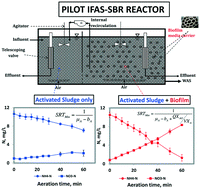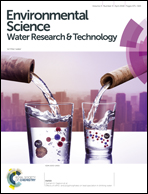Pilot scale study of sequencing batch reactor (SBR) retrofit with integrated fixed film activated sludge (IFAS): nitrogen removal and design consideration†
Abstract
Excessive nitrogen is a typical limiting factor for wastewater discharge. The IFAS process has been widely applied to meet more stringent organics and nitrogen discharge limits. However, very few studies have been conducted for the application of the IFAS process in sequencing batch reactors (SBRs). This study coupled the IFAS process with SBR operation in a pilot-scale reactor, aiming to verify the feasibility of IFAS-SBR combination and observe the process performance. Phased tests were conducted for different operations, such as nitrification only, modified Ludzack–Ettinger (MLE), etc. The results showed that IFAS-SBR was effective for organics removal with over 90% CBOD removal and an effluent CBOD of less than 25 mg L−1. Also, excellent NH4+-N removal, characterized by 96% removal efficiency and an average effluent concentration of 0.8 mg L−1, was achieved under low N loading (23.6 g-N per m3 per day) and sufficient solid retention time (SRT, 4.34 days). It was found that nitrification occurred with a SRT less than the minimum nitrifying SRT, which was attributed to the biofilm and its seeding effect. Kinetics tests showed that the IFAS surface NH4+-N removal rate was 0.69 g-N per m2 per day at 15 °C, and 31% of the NH4+-N removal capacity was contributed by the suspended-growth biomass, while 69% by the biofilm. The NH4+-N removal improvement was attributed to both attached-growth biomass on media carriers and the “seeding effect”. In addition, having an anoxic zone in SBR systems can reduce the number of trains for nitrogen removal applications compared to the pre-denitrification conventional SBR systems.



 Please wait while we load your content...
Please wait while we load your content...